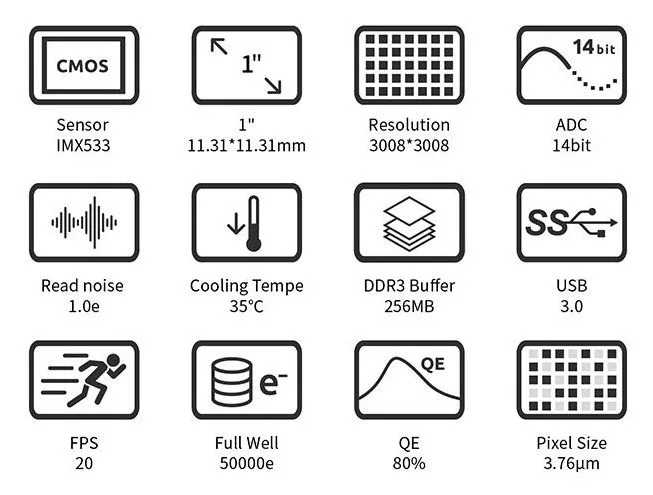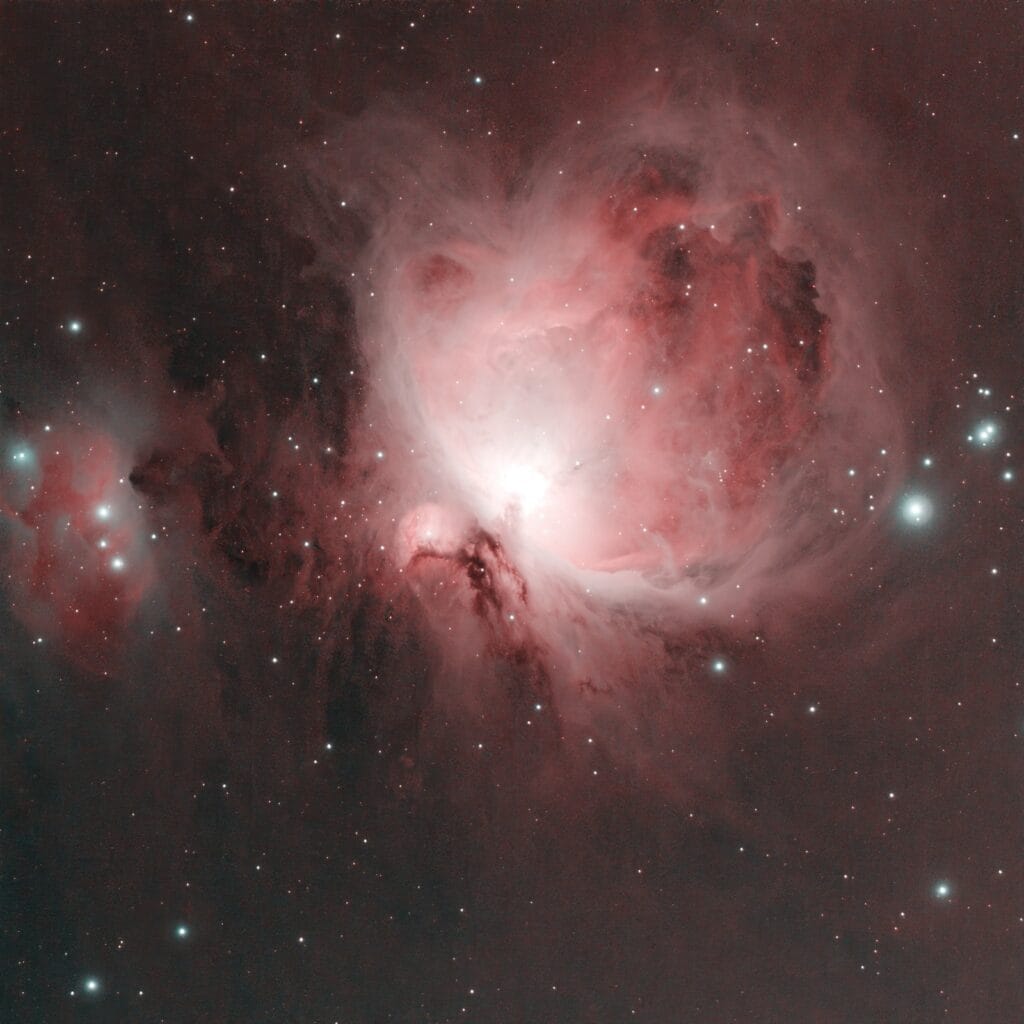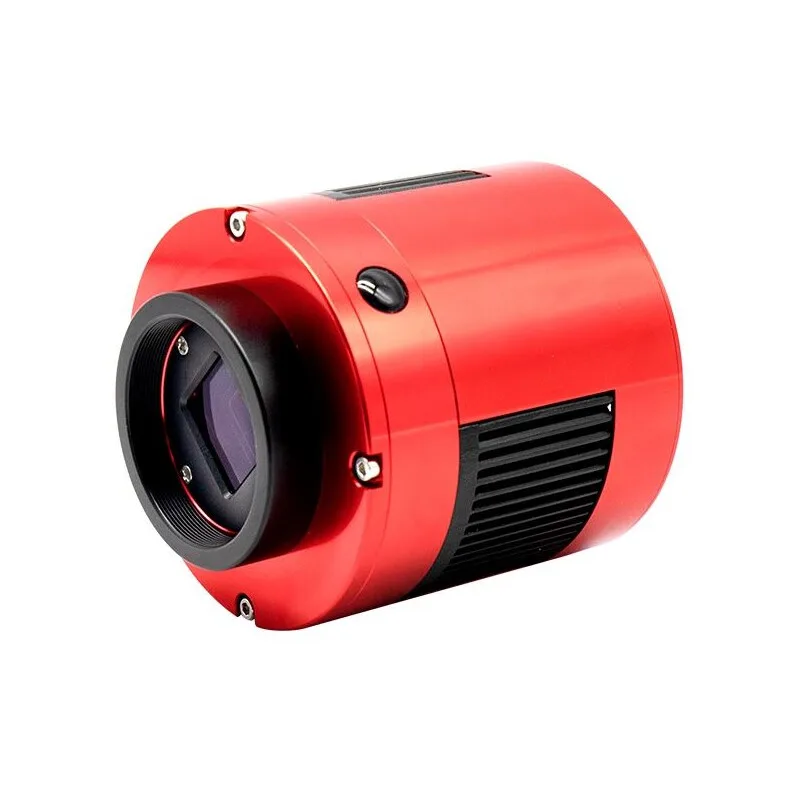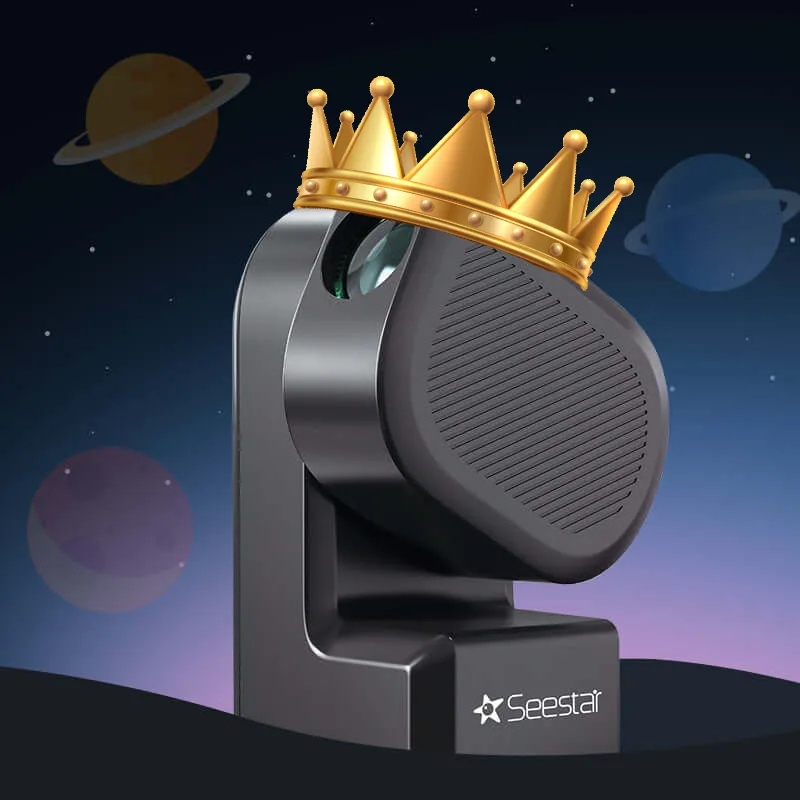Introduction and Key Features
The ZWO ASI533MC Pro is a popular one-shot colour (OSC) camera for astrophotography (also available in a mono version), offering a compelling balance between performance, usability, and cost. Equipped with Sony’s IMX533 CMOS sensor, it combines high sensitivity and low noise performance in a square 1″ format—an uncommon but very practical layout for deep-sky imaging.
It features a 3008 × 3008 resolution, 3.76 μm pixel size, and 14-bit ADC depth. Designed with regulated cooling and an integrated USB hub, the 533MC Pro is compact, reliable, and suitable for a wide range of telescope setups, particularly fast Newtonians and refractors.
Overview
- Clean, amp-glow-free sensor delivers efficient calibration and quality data.
- Compact square format offers intuitive framing for galaxies and nebulae.
- Regulated TEC cooling reaches –10 °C swiftly and reliably.
- High quantum efficiency (~80%) and low read noise support excellent image depth.
- Well-matched to mid-focal length telescopes and one-shot colour workflows.
Sensor and Image Quality
At the heart of the ASI533MC Pro is its back-illuminated CMOS sensor. With a quantum efficiency around 80% and pixel architecture that minimises read noise, this camera captures fine detail with strong signal-to-noise even at modest exposure lengths. The square sensor shape is especially handy for symmetrical framing of objects like galaxies and clusters, and is well-matched to mid-range focal lengths.
Unlike many OSC sensors, this model exhibits no visible amp glow, which simplifies dark frame calibration and helps maintain dynamic range across the entire field. Combined with low fixed-pattern noise and excellent hot pixel management, the resulting calibration frames are clean and consistent—especially important when stacking large numbers of sub-exposures.
[Insert an image comparing master dark frames with and without amp glow]
Cooling and Performance
The ASI533MC Pro’s regulated cooling system is robust, reaching target temperatures (e.g. –10 °C) quickly and maintaining them with stable power draw. It uses a two-stage thermoelectric cooler and active fan assembly, drawing 12 V via a standard DC input. Cooling performance is sufficient for year-round imaging in most climates, and temperature control is integrated seamlessly via software such as ASI Studio, NINA, or ASIAIR.
Noise performance benefits greatly from cooling, and consistent sensor temperature across calibration and imaging frames contributes to improved stacking results.
Build Quality and Connectivity
The camera features ZWO’s standard cylindrical housing in anodised aluminium. The finish is solid, with minimal flex or movement in cable ports. A USB 3.0 connection ensures high-speed data throughput, while two USB 2.0 ports on the back act as a powered hub for accessories such as filter wheels or focusers.
The 12 V power requirement is essential for cooling; the camera is not intended to operate in uncooled mode. Physically, the unit is compact and weighs just under 500 g, which makes it compatible with most imaging rigs, including travel-friendly mounts.

Field Performance and Practical Use
In the field, the 533MC Pro offers a very forgiving imaging experience. Frame calibration is straightforward thanks to the absence of amp glow and clean dark performance. Flat frames typically show only optical system artefacts, with no unusual noise patterns from the sensor itself. The camera also tolerates aggressive stretching well, making it suitable for deep-sky work even with moderate stacking times.
With its 16 mm diagonal sensor and relatively small pixels, the camera pairs best with telescopes in the ~400–800 mm focal length range. Fast systems, such as f/4–f/5 Newtonians or triplet refractors with reducers, make ideal partners. Framing is intuitive and works well for objects like the Leo Triplet, M51, or smaller emission nebulae.
Gain settings are straightforward: using the camera at or slightly above unity gain (100–101) is recommended to optimise dynamic range and minimise read noise. Dithering during capture is beneficial to mitigate hot pixels and improve final image quality, especially when stacking many short subs.
Choosing the Right Camera Pairing
The ASI533MC Pro is a strong choice for astrophotographers looking to simplify their workflow without sacrificing image quality. As a colour camera, it avoids the complexity of filter wheels and LRGB processing, making it particularly suitable for beginners and intermediate users looking to focus on capture and composition.
Its small, square sensor doesn’t offer the wide field of larger formats like the ASI294MC Pro, but what it lacks in area it makes up for in clean data, high reliability, and simplified processing. It’s also a perfect fit for imaging systems that don’t fully illuminate full-frame sensors, eliminating the need for large (and often expensive) field correctors.

Final Thoughts: Strengths and Limitations
The ZWO ASI533MC Pro is an excellent all-rounder in the cooled OSC category. It brings together many of the features astrophotographers value most: clean data, stable cooling, and compatibility with a wide range of systems. While it doesn’t offer a wide sensor format or the pixel area of full-frame models, it provides a near-flawless user experience at a reasonable price.
Strengths:
- Zero amp glow simplifies calibration and protects dynamic range.
- Square sensor layout is well-suited to common DSO framing.
- Excellent cooling stability and quick performance.
- Ideal for OSC users seeking a straightforward imaging setup.
Limitations:
- Modest sensor size limits wide-field applications.
- Requires attention to field matching for best results.
- Less suited to very large targets without mosaicking.
Overall, the ASI533MC Pro stands out as a reliable, low-maintenance camera for colour imaging. It’s a strong recommendation for astrophotographers who want dependable results without the complexity of mono setups.




